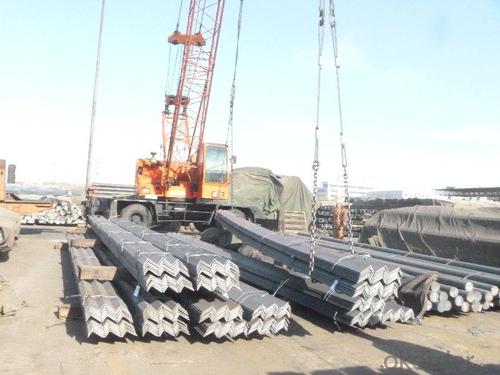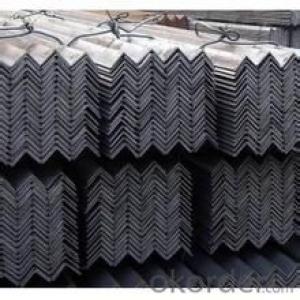hot rolled angle steel
- Loading Port:
- China Main Port
- Payment Terms:
- TT OR LC
- Min Order Qty:
- -
- Supply Capability:
- -
OKorder Service Pledge
OKorder Financial Service
You Might Also Like
Product Description:
1.Grade: SS200,300,400 series
2.Size: 25×25×3 mm-100×100×10mm
3.Process: HRAP
4. Length: 2-6m
5. Shape: Equal
6. Delivery: within 20 days
7. MOQ: 1 ton
8. Certificate: ISO 9001:2008, SGS
9. Package:Standard Export Packing, or put into wooden boxes according to your requirement
10. Application: Construction, Marine, Industry and so on
Name | Stainless Steel Angles | ||||||
Standard | ASTM A554, A312, A249, A269 and A270 | ||||||
Material Grade | 304,316,201,202, 316L,430 | ||||||
Length | 6m or as customers' request | ||||||
Tolerance | a) thickness: +/-0. 15mm | ||||||
| |||||||
b) Length:+/-4. 5mm - 0mm | |||||||
Surface | 180G, 320G, 400G Satin / Hairline(Matt Finish, Brush, Dull Finish) 400G, 500G, 600G or 800G Mirror finish | ||||||
Application | Decoration construction, upholstery, industry instruments | ||||||
Test | Squash test, Extended test, Water pressure test, Crystal rot test, Heat treatment, NDT | ||||||
Chemical Composition of Material |
Composition
Material | 201 | 202 | 304 | 316L | 430 | |
C | ≤0.15 | ≤0.15 | ≤0.08 | ≤0.08 | ≤0.12 | | |
Si | ≤1.00 | ≤1.00 | ≤1.00 | ≤1.00 | ≤1.00 | | |
Mn | 5.5-7.5 | 7.5-10 | ≤2.00 | ≤2.00 | ≤1.00 | | |
P | ≤0.06 | ≤0.06 | ≤0.045 | ≤0.045 | ≤0.040 | | |
S | ≤0.03 | ≤0.03 | ≤0.030 | ≤0.030 | ≤0.030 | | |
Cr | 16-18 | 17-19 | 18-20 | 16-18 | 16-18 | | |
Ni | 3.5-5.5 | 4-6 | 8-10.5 | 10-14 |
| | |
Mo |
|
|
| 2.0-3.0 |
| | |
Mechanical Property | Material Item | 201 | 202 | 304 | 316L | | |
Tensile Strength | ≥535 | ≥520 | ≥520 | ≥520 | | ||
Yield Strength | ≥245 | ≥205 | ≥205 | ≥205 | | ||
Extension | ≥30% | ≥30% | ≥35% | ≥35% | | ||
Hardness (HV) | <253 | <253 | <200 | <200 | | ||
- Q: What is the typical ductility of steel angles?
- The typical ductility of steel angles can vary depending on the specific grade and composition of the steel. However, in general, steel angles have good ductility due to the inherent properties of steel, which allows them to be easily bent or deformed without breaking.
- Q: Can iron angle steel be welded with stainless steel angle steel?
- If the angle, in a cross-sectional angle welding of carbon steel plate, stainless steel angle welding a stainless steel cross sectional iron. Two cross cutting iron plate punching, 8.8 high strength screw fastening piece.Carbon steel and stainless steel welding, belong to dissimilar metal welding. Higher requirements for welding technology. Screw connections are the most economical,
- Q: Can steel angles be used for framing or supporting mezzanines or elevated platforms?
- Framing or supporting mezzanines or elevated platforms can indeed be achieved with the use of steel angles. In construction projects, steel angles are widely employed due to their structural strength and versatility. They serve as reliable supports or braces in various applications, including the framing of mezzanines or elevated platforms. By providing stability and structural integrity, steel angles prove to be an excellent option for bearing heavy loads and establishing a sturdy framework. Their L-shaped design facilitates easy installation and ensures exceptional resistance against bending and shearing forces. Moreover, steel angles can be effortlessly welded or bolted together, allowing for flexibility in design and construction. All in all, steel angles emerge as a dependable and efficient choice when it comes to framing or supporting mezzanines or elevated platforms.
- Q: What are the different types of steel angles used in fencing and gates?
- Fencing and gates commonly utilize several types of steel angles. An example is the equal angle, also known as the L-shaped angle, which has sides of equal length. It is frequently employed for vertical and horizontal bracing in fencing and gates. Another variant is the unequal angle, which features one longer side and one shorter side. This type is often used for diagonal bracing, providing added strength and stability to fencing and gates. The rounded edge angle is another option, replacing sharp corners with rounded edges. This choice is favored in fencing and gates to minimize the risk of injury, as the rounded edges are less likely to cause cuts or other accidents. Additionally, there are slotted angles that come with pre-drilled holes along their length. These holes facilitate the easy attachment of fencing and gate components such as panels or hinges. Finally, galvanized angles are coated with a layer of zinc to safeguard against rust and corrosion. This type is particularly suitable for outdoor fencing and gates, offering long-lasting durability and resistance to the elements. In conclusion, the various types of steel angles used in fencing and gates provide different advantages in terms of strength, stability, safety, ease of installation, and resistance to rust and corrosion. The choice of angle will depend on the specific requirements and preferences of each fencing or gate project.
- Q: 100 x 100 x 10 equal angle steel, per meter weight?
- Angle steel is a kind of carbon structural steel for construction. It is a simple section steel, mainly used in the frame of metal component and workshop. In use, better weldability, plastic deformation and mechanical strength are required. The raw steel billet for producing angle steel is low carbon square billet, and the finished product angle iron is made by hot rolling, normalizing or hot rolling.
- Q: How do steel angles contribute to the overall stability of a building frame?
- Steel angles contribute to the overall stability of a building frame by providing structural support and reinforcement. They are commonly used as braces and connections in building frames to increase their load-bearing capacity and resist forces such as wind, earthquakes, and heavy loads. The angles help distribute and transfer the loads throughout the structure, enhancing its stability and preventing deformation or collapse.
- Q: Are steel angles resistant to impact or vibration?
- Steel angles exhibit resistance to both impact and vibration. The strength and toughness of steel make it highly resistant to impact, as it is capable of absorbing and distributing the force generated by an impact, thereby preventing any structural damage. Additionally, steel angles possess a high natural frequency, enabling them to withstand vibrations without experiencing significant deformation or failure. Nevertheless, the resistance of steel angles to impact and vibration may vary depending on factors such as the specific grade and thickness of the steel, as well as the intensity and duration of the impact or vibration. Therefore, it is crucial to carefully consider the specific requirements and conditions of the application when evaluating the suitability of steel angles for impact and vibration resistance.
- Q: How do you prevent steel angles from vibrating?
- There are a few ways to prevent steel angles from vibrating. One effective method is to use vibration damping materials such as rubber pads or isolation mounts between the steel angles and any adjacent surfaces. Another approach is to add additional supports or braces to the steel angles to enhance their stability and reduce any potential vibrations. Additionally, ensuring proper tightening of fasteners and connections can help minimize vibrations.
- Q: Can steel angles be used for stairs in industrial settings?
- Yes, steel angles can be used for stairs in industrial settings. Steel angles are commonly used in the construction industry for various applications, including staircases. Their robust and durable nature makes them ideal for industrial settings where safety and strength are essential. Steel angles provide structural support and stability to staircases, allowing them to withstand heavy loads and frequent use. Additionally, steel angles can be easily welded, ensuring a secure and long-lasting staircase. Their versatility allows for customization to specific design and space requirements. Therefore, steel angles are a suitable choice for stairs in industrial settings.
- Q: What are the different types of steel angles used in architectural façade systems?
- There are several different types of steel angles used in architectural façade systems, including equal leg angles, unequal leg angles, L-shaped angles, and custom fabricated angles. These angles are used to provide structural support, create visual interest, and enhance the overall design of the building's exterior.
Send your message to us
hot rolled angle steel
- Loading Port:
- China Main Port
- Payment Terms:
- TT OR LC
- Min Order Qty:
- -
- Supply Capability:
- -
OKorder Service Pledge
OKorder Financial Service
Similar products
Hot products
Hot Searches
Related keywords



























